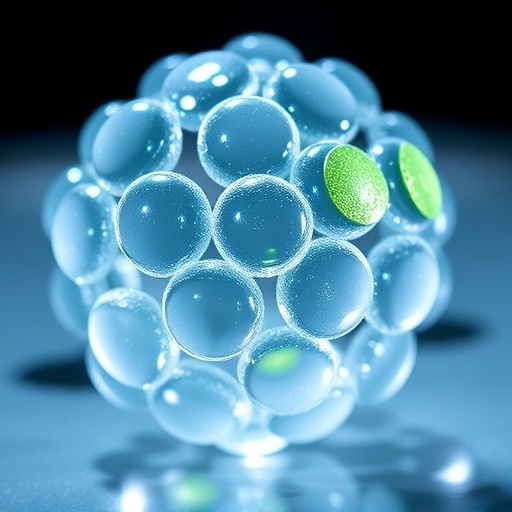In the rapidly evolving field of biofabrication, a groundbreaking technique known as aspiration-assisted bioprinting (AAB) has emerged, paving the way for more precise engineering of biological structures. This innovative method is a significant advancement over traditional bioprinting techniques, which have often faced challenges in achieving the fine control required for complex biological models. With the ability to accurately position biologics, such as tissue spheroids and organoids, AAB addresses the pressing need for creating sophisticated tissue models that mimic the three-dimensional environments found in vivo.
The essence of AAB lies in its versatile operational modes, which offer researchers the flexibility to choose their approach based on specific project requirements. In its single-nozzle mode, the technique allows for meticulous one-by-one bioprinting of spheroids, ensuring that each element is placed with precision and care. This level of control is particularly advantageous when fine-tuning cellular arrangements within a tissue structure, allowing for the recreation of intricate cellular interactions that are critical for studying pathophysiology and therapeutic responses.
In contrast, the high-throughput mode of AAB utilizes a digitally controllable nozzle array to enable rapid and simultaneous placement of multiple spheroids. This capability is especially valuable when large-scale tissue fabrication is needed, as it significantly reduces bioprinting time, accomplishing the task of placing 64 spheroids within a mere 3 to 4 minutes. This efficiency not only enhances productivity but also promotes scalability in the development of microphysiological systems, which are instrumental in drug testing procedures and disease modeling.
AAB serves as a transformative tool in addressing the limitations typically faced by conventional bioprinting practices that often struggle with issues of cell density and spatial arrangement. This technique allows for the fabrication of tissues with physiologically relevant cell densities, which is essential for establishing more accurate models of human physiology. By leveraging the natural tendency of cells to form spheroids, AAB creates environments that closely replicate actual tissue architecture, leading to more meaningful insights in biological research and clinical applications.
The intricacy of the AAB process necessitates meticulous attention to detail, particularly in setting up the bioprinting platform. The protocol outlined for AAB emphasizes the importance of operational consistency and reproducibility, detailing comprehensive instructions that guide users in establishing their bioprinting systems. Such guidelines are vital for researchers from various backgrounds—ranging from engineering to medical sciences—who seek to harness the potential of AAB in their work.
Operating software for AAB is designed to be user-friendly, offering intuitive functionalities that simplify the programming of bioprinting procedures. The focus on accessibility ensures that researchers, regardless of their technical expertise, can quickly become proficient in utilizing this advanced bioprinting method. The optimization of bioprinting conditions, as highlighted within the protocol, serves as a critical step toward achieving successful outcomes with AAB, allowing users to hone their approaches based on specific biological contexts and applications.
The rapid advancement of tissue engineering and regenerative medicine with AAB has opened up new avenues for exploring cellular behavior and tissue interaction dynamics. By enabling the precise positioning of spheroids, AAB not only facilitates the study of cellular responses in response to therapeutic agents but also fosters the development of implantable grafts designed for regenerative purposes. This dual application underscores the relevance of AAB in bridging the gap between experimental research and clinical implementation, potentially revolutionizing patient care approaches.
In highlighting the impact of AAB, it’s important to note its potential applications in the rapidly growing field of personalized medicine. The ability to tailor tissue constructs for individual patient needs through customizable bioprinting platforms stands to enhance the efficacy and safety of therapeutic interventions. As personalized medicine continues to shape the future of healthcare, techniques like AAB will play an increasingly critical role in the development of patient-specific treatment modalities.
Additionally, the multi-faceted nature of AAB makes it an ideal candidate for interdisciplinary collaboration, fostering partnerships among experts in fields such as materials science, biology, and pharmacology. The synthesis of knowledge and expertise across these domains can lead to innovative solutions and insights, propelling forward the frontier of biofabrication and its applications in health sciences.
As researchers and institutions pursue further advances in AAB technology, the pursuit of integrating more complex cellular models into bioprinting processes remains a critical objective. Continuous refinements in the technique, alongside advancements in materials and bioinks, will significantly contribute to the sophistication of tissue constructs that can be produced, ultimately leading to more refined and functional models for use in research and therapeutic settings.
Despite the promising trajectory of AAB, challenges remain in ensuring the long-term viability and functionality of bioprinted tissues. Ongoing research will need to address key questions regarding the adaptability of bioprinted constructs within living systems and their integration into host tissues. These inquiries will not only shape the future of AAB but also inform broader advancements within the field of regenerative medicine.
In conclusion, aspiration-assisted bioprinting stands at the forefront of biofabrication innovation, equipped with the potential to enhance our understanding of complex biological systems while enabling practical applications in medicine. As protocols for AAB become refined and widely adopted, the scientific community can look forward to a new era of research that leverages these technologies to create more accurate models of human biology, ultimately contributing to improved therapeutic paradigms and patient outcomes.
Subject of Research: Aspiration-assisted bioprinting of spheroids.
Article Title: Aspiration-assisted bioprinting of spheroids.
Article References:
Kim, M.H., Ozbolat, I.T. Aspiration-assisted bioprinting of spheroids.
Nat Protoc (2025). https://doi.org/10.1038/s41596-025-01240-x
Image Credits: AI Generated
DOI: 10.1038/s41596-025-01240-x
Keywords: Aspiration-assisted bioprinting, bioprinting, biofabrication, tissue engineering, spheroids, organoids, regenerative medicine, microphysiological systems, drug testing, disease modeling.




